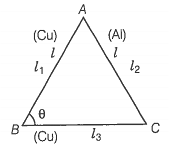Q.27. An equilateral triangle ABC is formed by two Cu rods AB and BC and one Al rod. It is heated in such a way that the temperature of each rod increases by . Find the change in the angle ABC. [coeffecient of linear expansion for Cu is , coefficient of linear expansion for Al is ]


© 2025 GoodEd Technologies Pvt. Ltd.